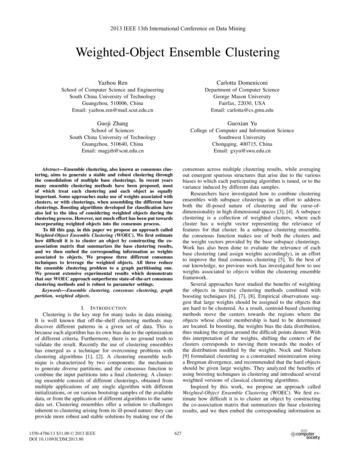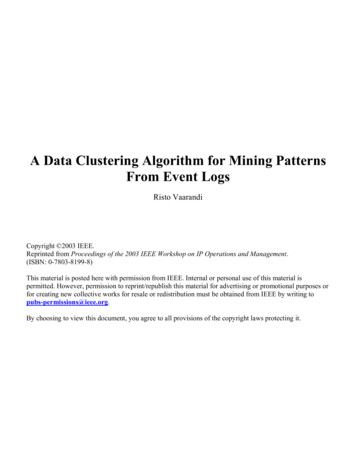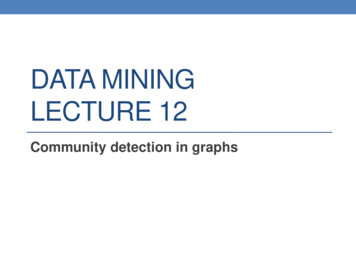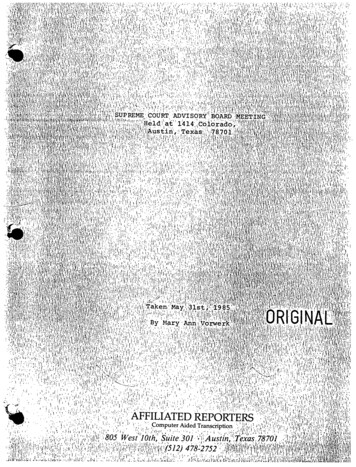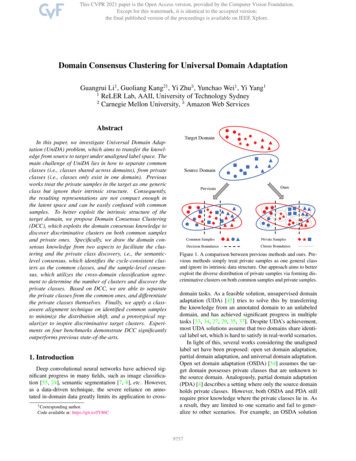
Transcription
Domain Consensus Clustering for Universal Domain AdaptationGuangrui Li1 , Guoliang Kang2† , Yi Zhu3 , Yunchao Wei1 , Yi Yang11ReLER Lab, AAII, University of Technology Sydney2Carnegie Mellon University, 3 Amazon Web ServicesAbstractIn this paper, we investigate Universal Domain Adaptation (UniDA) problem, which aims to transfer the knowledge from source to target under unaligned label space. Themain challenge of UniDA lies in how to separate commonclasses (i.e., classes shared across domains), from privateclasses (i.e., classes only exist in one domain). Previousworks treat the private samples in the target as one genericclass but ignore their intrinsic structure. Consequently,the resulting representations are not compact enough inthe latent space and can be easily confused with commonsamples. To better exploit the intrinsic structure of thetarget domain, we propose Domain Consensus Clustering(DCC), which exploits the domain consensus knowledge todiscover discriminative clusters on both common samplesand private ones. Specifically, we draw the domain consensus knowledge from two aspects to facilitate the clustering and the private class discovery, i.e., the semanticlevel consensus, which identifies the cycle-consistent clusters as the common classes, and the sample-level consensus, which utilizes the cross-domain classification agreement to determine the number of clusters and discover theprivate classes. Based on DCC, we are able to separatethe private classes from the common ones, and differentiatethe private classes themselves. Finally, we apply a classaware alignment technique on identified common samplesto minimize the distribution shift, and a prototypical regularizer to inspire discriminative target clusters. Experiments on four benchmarks demonstrate DCC significantlyoutperforms previous state-of-the-arts.1. IntroductionDeep convolutional neural networks have achieved significant progress in many fields, such as image classification [55, 24], semantic segmentation [7, 8], etc. However,as a data-driven technique, the severe reliance on annotated in-domain data greatly limits its application to cross† Correspondingauthor.Code available at: https://git.io/JY86CTarget DomainSource DomainPreviousOursCommon SamplesPrivate SamplesDecision BoundariesCluster BoundariesFigure 1. A comparison between previous methods and ours. Previous methods simply treat private samples as one general classand ignore its intrinsic data structure. Our approach aims to betterexploit the diverse distribution of private samples via forming discriminative clusters on both common samples and private samples.domain tasks. As a feasible solution, unsupervised domainadaptation (UDA) [45] tries to solve this by transferringthe knowledge from an annotated domain to an unlabeleddomain, and has achieved significant progress in multipletasks [33, 34, 27, 29, 35, 37]. Despite UDA’s achievement,most UDA solutions assume that two domains share identical label set, which is hard to satisfy in real-world scenarios.In light of this, several works considering the unalignedlabel set have been proposed: open set domain adaptation,partial domain adaptation, and universal domain adaptation.Open set domain adaptation (OSDA) [54] assumes the target domain possesses private classes that are unknown tothe source domain. Analogously, partial domain adaptation(PDA) [4] describes a setting where only the source domainholds private classes. However, both OSDA and PDA stillrequire prior knowledge where the private classes lie in. Asa result, they are limited to one scenario and fail to generalize to other scenarios. For example, an OSDA solution9757
would fail in the PDA scenario as it only seeks private samples in the target domain. To solve this, [62] takes a stepfurther to propose a more general yet practical setting, universal domain adaptation (UniDA), which allows both domains to own private classes.The main challenge of transferring over unaligned label space is how to effectively separate common samplesfrom private samples in both domains. To achieve thisgoal, many efforts have been devoted to performing common sample discovery from different perspectives, such asdesigning new criteria [4, 3, 62, 17, 53] or introducing extra discriminator [63, 5, 38, 9]. However, previous practicesmainly focus on identifying common samples but treat private samples as a whole, i.e., unknown class (Bottom leftin Fig. 1). Despite making progress, the intrinsic structure(i.e., the variations within each semantic class and the relationships between different semantic classes) of the privatesamples is not fully exploited. As the private samples in nature belong to distinct semantic classes, treating them as onegeneral class is arguably sub-optimal, which further induceslower compactness and less discriminative target representations.In this paper, we aim to better exploit the intrinsic structure of the target domain via mining both common classesand individual private classes. We propose Domain Consensus Clustering (DCC), which utilizes the domain consensus knowledge to form discriminative clusters on both common samples and private samples (Bottom right in Fig. 1).Specifically, we mine the domain consensus knowledgefrom two aspects, i.e., semantic-level and sample-level, andintegrate them into two consecutive steps. Firstly, we leverage Cycle-Consistent Matching (CCM) to mine the semantic consensus among cluster centers so that we could identify common clusters from both domains. If two clustercenters reach consensus, i.e., both centers act as the other’snearest center simultaneously, this pair will be regardedas common clusters. Secondly, we propose a metric, domain consensus score, to acquire cross-domain classification agreements between identified common clusters. Concretely, domain consensus score is defined as the proportionof samples that hold corresponding cluster label across domains. Intuitively, more samples reach consensus, the distribution shift between matched clusters is smaller. Therefore, domain consensus score could be regarded as a constraint that ensures the precise matching of CCM. Moreover, domain consensus score also offers a necessary guidance that determines the number of target clusters, and encourages the samples to be grouped into clusters of bothcommon and private classes. Finally, for those commonclusters with high domain consensus scores, we exploit aclass-aware alignment technique on them to mitigate thedistribution shift. As for those centers that fail to find theirconsensus counterparts, we also enhance their cluster-basedconsistency. To be specific, we employ a prototypical regularizer to encourage samples to approach their attachedcluster centers. In this way, those samples belonging todifferent private categories will be encouraged to be distinguishable from each other, which also contributes to learning better representations.Our contribution can be summarized as: 1) We tackle theUniDA problem from a new perspective, i.e., differentiating private samples into different clusters instead of treatingthem as whole. 2) We propose Domain Consensus Clustering (DCC), which mines domain consensus knowledgefrom two levels, i.e., semantic-level and sample-level, andguides the target clustering in the absence of prior knowledge. 3) Extensive experiments on four benchmarks verify the superior performance of proposed method comparedwith previous works.2. Related worksClosed Set Domain Adaptation, also known as unsupervised domain adaptation (UDA), assumes two domainsshare identical label set. The main focus lies in how to minimize the distribution shift. Some methods minimize thediscrepancy in the feature space directly [40, 39, 56, 59, 42,61, 30, 16]. Some recent works take advantage of adversarial training to promote the alignment in the input space [11,23, 25, 20, 10] or feature space [58, 44, 6, 18, 38, 64, 43].Moreover, there are also some works performing adaptationvia clustering in the target domain [28, 57]. However, theycould not trivially generalize to the unaligned label space.Partial Domain Adaptation (PDA) holds an assumption that private classes only lie in the source domain, whichhas received wide attention recently. SAN [3] employsclass-wise domain discriminators to align the distributionsin a fine-grained manner. IWAN [63] proposes to identifycommon samples with the domain similarities from the domain discriminator, and utilizes the similarities as weightsfor adversarial training. Recently, ETN [5] proposes a progressive weighting scheme to estimate the transferabilityof source samples, while BA3 US [36] incorporates an augmentation scheme and a complement entropy to avoid negative transfer and uncertainty propagation, respectively.Open Set Domain Adaptation (OSDA). Different settings [54, 46, 1, 14] have been investigated for the openset domain adaptation. In this paper, we mainly focuson the setting proposed by [54], where the target domain holds private classes that are unknown to the source.OSBP [54] proposes an adversarial learning framework thatenables the feature generator to learn representations toachieve common-private separation. Recent works [38, 15]follow this paradigm to draw the knowledge from thedomain discriminator to identify common samples thatshare the semantic classes across domains. ROS [1] employs self-supervised learning technique to achieve the9758
SourceSamples(b)SourceClusteringCycle-Consistent MatchingDomain Consensus Score0.43Cycle-ConsistentMatchingTargetClustering 1TargetSamples0.830.62TargetClustering 2iv. Determine the Optimal ClusteringTargetClustering 3(a)i. Multiple Clusteringsii. Cycle-Consistent Matchingiii. Domain Consensus ScoreSource CentersTarget CentersMatched ClustersNearest Cluster CenterFigure 2. (a) Illustration of Domain Consensus Clustering (DCC). i) As the number of target classes is not given, we aim to select theoptimal target clustering from multiple candidates. ii) For obtained target clusters, we leverage cycle-consistent matching (CCM) toidentify clusters representing common classes from both domains. iii) Then we utilize domain consensus score to estimate the degree ofagreement between matched clusters. iv) Finally, based on the domain consensus score, we could determine the optimal target clustering.(b) Illustration of Cycle-Consistent Matching. If two clusters from different domains act as the other’s nearest neighbor, samples from thetwo clusters are identified as common samples that share the same semantic labels.known/unknown separation and domain alignment.Universal Domain Adaptation (UniDA), as a morechallenging scenario, allows both domains having their ownprivate classes. UAN [62] proposes a criterion to quantify sample-level uncertainty based on entropy and domainsimilarity. Then samples with lower uncertainty are encouraged for adaptation with higher weight. However, aspointed by [17], this measurement is not discriminative androbust enough. Fu et al. [17] designs a better criterion thatcombines entropy, confidence, and consistency from auxiliary classifiers to measure sample-level uncertainty. Similarly, a class-wise weighting mechanism is applied for subsequent adversarial alignment. However, they both treat private samples as one general class while ignoring the intrinsic structure of private samples.Compared with previous works, our work differs fromthem mainly in two aspects. First, most previous approaches perform sample-independent evaluation to separate common samples and private samples, while we consider a cluster-based method to better exploit the intrinsicstructure of target samples. Second, our approach providesa unified framework to deal with different sub-cases of universal domain adaptation, i.e., OSDA, PDA, and UniDA.3. PreliminariesIn universal domain adaptation, we are provided with annsnotated source samples Ds {(xsi , yis )}i 1 , and unlabelednttarget samples Dt {(xti )}i 1 . Since the label set may notbe identical, we use C s , C t to represent label set for twodomains accordingly. Then we denote C C s C t as thecommon label set. We aim to train a model on Ds and Dtto classify target samples into C 1 classes, where privatesamples are grouped into one unknown class.The model consists of two modules: (1) feature extractorfφ that maps the input images into vector representation:v fφ (x), and (2) classifier gφ that assigns each featurerepresentation v into one of C s classes: p gφ (v). Forsamples from two domains, we group them into clusters,respectively. The cluster assignment of source samples isbased on the ground truth and the source center is the meanembedding of source samples within one specific class. Fornscthe c-th source cluster Dcs {xsi }i 1, its cluster center is:µsc 1 X fφ (xsi ).nsc s s fφ (xsi ) (1)xi DcAs for target samples, we adopt K-means to group them intoK clusters and obtain corresponding centers {µt1 , ., µtK }.4. MethodologyIn this paper, we aim to utilize the domain consensusknowledge to guide the target clustering, which exploits theintrinsic structure of the target representations. Specifically,we mine the domain consensus knowledge from two levels.Firstly, the semantic-level consensus among cluster centersis utilized to identify cycle-consistent clusters as commonclasses (§ 4.1). Secondly, we design a novel metric named“domain consensus score” to utilize the sample-level consensus to specify the number of target clusters (§ 4.2). Finally, we discuss the cluster optimization and objectives in§ 4.3. The overview of our approach is presented in Fig. 2.4.1. Cycle-Consistent MatchingThe main challenge of universal domain adaptation ishow to separate common samples from private samples.9759
Matched PairSource ClusterTarget ClusterConsensus Score on Source Samples: 3/4Consensus Score on Target Samples: 2/4Domain Consensus Score Cluster Centers:" ##/2 0.625lizes the sample-level consensus to determine the numberof target clusters, thus forming discriminative clusters.As shown in Fig. 3, for each sample from paired clusters, we search for its nearest cluster in the other domain,and then determine if it reaches consensus, i.e., this sampleholds corresponding cluster label across domains. Throughcollecting samples that reach consensus, the agreement forthis pair of clusters can be evaluated.Concretely, given a pair of matched clusters {vis }mi 1 andt n{vi }i 1 with corresponding centers µsc and µtk , we aim tomeasure the sample-level consensus from two views, i.e.,the source view and the target one. To obtain consensusscore on source view, for each source sample, we calculateits similarities with all target cluster centers {µt1 , ., µtK }:Cluster Samples:Figure 3. Illustration of Domain Consensus Score. For each sample from matched clusters, we search for its nearest cluster centerin the other domain. Then domain consensus score is calculated asthe proportion of samples that reach consensus, i.e., the labels oftheir nearest cluster centers in the other domain match with thoseachieved by CCM.Unlike previous works [62, 17] that perform sample-levelidentification on the common samples, this paper aims tomine both common classes and individual private classessimultaneously with discriminative clusters. Now a question naturally arises: how to associate common clusters thatrepresent the same semantic classes from both domains?To achieve this, we propose Cycle-Consistent Matching(CCM) to link clusters from the same common classesthrough mining semantic-level consensus.As illustrated in Fig. 2 (b), for each cluster center, wesearch for its nearest cluster center in the other domain. Iftwo clusters reach consensus, i.e., both act as the other’snearest center simultaneously, such a pair of clusters is recognized as common clusters. The intuition here is simple:cluster centers from the same class usually lie close enoughto be associated compared to the clusters representing private classes. Further, to ensure this assumption, we utilizethe sample-level consensus to promote the effectiveness ofCCM, which is detailed in the next section.4.2. Domain Consensus ScoreEnabled by CCM, we could identify common samplesfrom both domains. Nevertheless, another problem is notyet solved: how to determine the number of target clusters without knowing the exact number of underlying targetclasses? To solve this, one plausible solution is to adoptexisting clustering evaluation criteria [51, 12, 2] to estimatethe number of clusters. However, these techniques are designed for the single-domain scenario and cannot directlytake cross-domain knowledge into consideration. Hence,we propose a metric, domain consensus score, which uti-sri,k Sim(vis , µtk ), k {1, ., K},(2)where Sim(·) denotes the cosine similarity, i.e.,ha,bi. Then the consensus score couldSim(a, b) kakkbkbe formulated as the proportion of samples that reachconsensus:Pmsi 1 1{arg maxk (ri,k ) k}sS(c,k) ,(3)mswhere 1{arg maxk (ri,k) k} is a indicator to judge if visholds corresponding cluster index (k) across domains.Analogously, we could obtain the consensus score onttarget samples S(c,k). Then we average the score of twoviews to obtain the consensus score of this matched pair,Ss S ti.e., S(c,k) (c,k) 2 (c,k) . Finally, we calculate the meanof consensus scores of all matched pairs of clusters.To specify the number of target clusters K, we performmultiple clusterings with different K and then we determine the optimal one according to the domain consensusscore. Concretely, for different instantiations of K whichare equally spaced, we compute the consensus score foreach one, and the instantiation of K with the highest scoreis chosen for subsequent clustering.Empirically, we find DCC tends to separate samplesfrom one class into multiple clusters at the beginning, whichis also known as over-clustering. The reason is that toachieve a higher consensus score, more accurate matchingbetween clusters is preferred. Consequently, at the beginning, DCC prefers small clusters with “easy” samples (i.e.less impacted by the domain shift), which may make thenumber of clusters larger than the underlying number oftarget classes. As the adaptation proceeds, the number ofclusters tends to decrease and converges to a certain number after a period of training.4.3. Cluster Optimization and ObjectivesIn this section, we first introduce the clustering updatestrategy. Then we enumerate objectives, i.e., prototypical9760
regularizer, contrastive domain discrepancy. Finally, wepresent the overall objective and the weight of each item.Alternative Update. To avoid the accumulation of inaccurate labels, we optimize the model and update the clustering alternatively. Ideally, we expect to specify the numberof clusters K with only one search, but it is impossible dueto the large domain gap at the initial stage. Hence, DCCspecifies the K based on domain consensus score for eachupdate of the clustering. Empirically we find that: 1) ineach round of searching, the domain consensus scores exhibit a bell curve as K increases. 2) K converges to a specific value after several initial rounds of searching, i.e. afterearly stages of training. Motivated by these observations,we adopt two stopping criteria to improve the efficiency ofsearching, i.e., stop the searching once the consensus scoredrops a certain number of times continuously, and fix the Konce it holds a certain value for a certain number of rounds.Prototypical Regularizer. To enhance the discriminability of target clusters, we impose a prototypicalregularizer on target samples. Specifically, let M [µt1 , µt2 , ., µtK ] denotes the prototype bank that stores allL2-normalized target cluster centers and these prototypesis updated iteratively during training. Then the regularizercould be formulated as:Lreg nt XKXtŷi,klog p̂(i,k) ,(4)i 1 k 1where ŷit is the one-hot cluster label, andexp(vi T µtk /τ ).p̂(i,k) PKT tk 1 exp(vi µk /τ )(5)Here vi is L2-normalized feature vector of target samples.τ is a temperature parameter that controls the concentrationof the distribution [22], and we set it to 0.1 empirically.Contrastive Domain Discrepancy (CDD). Since theidentified common samples are grouped into clusters, weleverage CDD [28, 27] to facilitate the alignment over identified common samples in a class-aware style. We imposeLcdd to minimize the intra-class discrepancies and enlargethe inter-class gap. Consequently, the enhanced discriminability, in turn, enables DCC to perform more accurateclustering. Details of CDD are provided in Appendix. A.Overall Objective. The model is jointly optimized withthree terms, i.e., cross-entropy loss on source samples Lce ,domain alignment loss Lcdd , and the regularizer Lreg :L Lce λLcdd γLreg ,Lce Cs ns XXi 1 c 1sŷi,clog(σ(gφ (fφ (xsi ))),(6)(7)where σ denotes the softmax function, and ŷis is the one-hotencoding of source label. λ is set to 0.1 for all datasets.As mentioned, the target clustering usually converges tothe optimal one after several rounds of searching, so simplyapplying a constant weight on Lreg may hinder the convergence as it promotes the inter-cluster separation. Therefore,iwe apply a ramp-up function on γ, i.e., γ e ω N , wherei and N denote current and global iteration, and ω 3.0.Such an incremental weight allows the size of clusters togrow in the earlier stage while prevents from absorbing extra private samples after saturated.Inference. At inference stage, we do not perform anyclustering. With the prototypes M [µt1 , µt2 , ., µtK ], wecan assign each sample a label same with the nearest prototype. In this way, common samples can be naturally separated from private ones in target domain.5. Experiments5.1. SetupBesides the setting [62] where private classes exist inboth domains (UniDA), we also validate our approach onother two sub-cases, i.e. partial domain adaptation (PDA)and open set domain adaptation (OSDA).Dataset. We conduct experiments on four datasets.Office-31 [52] consists of 4652 images from three domains: DSLR (D), Amazon (A), and Webcam (W). OfficeHome [60] is a more challenging dataset, which consists of15500 images from 65 categories. It is made up of 4 domains: Artistic images (Ar), Clip-Art images (CI), Productimages (Pr), and Real-World images (Rw). VisDA [50],is a large-scale dataset, where the source domain contains15K synthetic images and the target domain consists of 5Kimages from the real world. DomainNet [49] is the largestdomain adaptation dataset with about 0.6 million images.Like [17], we conduct experiments on three subsets from it,i.e., Painting (P), Real (R), and Sketch (S).Following existing works [47, 54, 4, 62], we separate thelabel set into three parts: common classes C, source-privateclasses Ĉs and target-private classes Ĉt . The separation offour datasets is described in Table 3. The classes are separated according to their alphabetical order.Evaluation. For all experiments, we report the averagedresults of three runs. In OSDA and UniDA, target-privateclasses are grouped into a single unknown class, and we report two metrics, i.e., Acc. and HM, where the former isthe mean of per-class accuracy over common classes andunknown class, and the latter is the harmonic mean on accuracy of common samples and private ones like [17, 1]. InVisDA under OSDA, we present OS and OS* results as previous works [54, 38], where OS is same as Acc. and OS*only calculates the mean accuracy on common classes. InPDA, we report the mean of per-class accuracy over com-9761
A WUniDATable 1. Results (%) on Office-31 for UniDA (ResNet-50).W DA DD AD WW AAvgAcc.HMAcc.HMAcc.HMAcc.HMAcc.HMAcc.HMAcc.HMDANN [19]RTN [41]IWAN [63]PADA [4]ATI [47]OSBP [54]UAN [62]CMU .7088.5090.4370.1891.9775.8793.0880.16Table 2. HM (%) on Office-Home for UniDA (ResNet-50).UniDAAr ClAr PrAr RwCl ArCl PrCl RwPr ArPr ClPr RwRw ArRw ClRw PrAvgDANN [19]RTN [41]IWAN [63]PADA [4]ATI [47]OSBP [54]UAN [62]CMU .6277.5264.3473.6074.9480.9675.1280.3870.18Table 3. The division on label set, i.e., Common Class (C) /Source-Private Class ( Cˆs ) / Target Private Class ( Ĉt ).Class Split ( C / Cˆs / Ĉt )DatasetPDAOSDAUniDAOffice-3110 / 21 / 0 10 / 0 / 1110 / 10 / 11OfficeHome 25 / 40 / 0 25 / 0 / 4010 / 5 / 50VisDA 6/0/66/3/3DomainNet 150 / 50 / 145mon classes.Implementation details. Our implementation is basedon PyTorch [48]. We start from ResNet-50 [21] with thebackbone pretrained on ImageNet [13]. The classifier consists of two fully-connected layers, which follows the previous design [62, 17, 54, 4]. For a fair comparison, we adoptVGGNet [55] as backbone for OSDA task on VisDA.We optimize the model using Nesterov momentum SGDwith momentum of 0.9 and weight decay of 5 10 4 . Thelearning rate decays with the factor of (1 α Ni ) β , wherei and N denote current iteration and global iteration, andwe set α 10 and β 0.75. The batch size is set to 36.The initial learning rate is set to 1 10 4 for Office-31 andVisDA, and 1 10 3 for Office-Home and DomainNet.5.2. Comparison with previous state-of-the-artsWe compare our method with previous state-of-the-artsin three sub-cases of universal domain adaptation, i.e.,OSDA, PDA, and UniDA. For OSDA and PDA, we compare our method to the universal domain adaptation methods, without knowing the prior that private classes existTable 4. Results (%) on VisDA for OSDA (VGGNet) and UniDA(ResNet-50). *: variants of OSVM using MMD and DANN.OSDAUniDAMethodMethodOS OS*Acc.HMOSVM [26]52.5 54.9 RTN [41]53.92 26.02MMD OSVM* 54.4 56.0 IWAN [63]58.72 27.64DANN OSVM* 55.5 57.8 ATI [47]54.81 26.34ATI-λ [47]59.9 59.0 OSBP [54]30.26 27.31OSBP [54]62.9 59.2 UAN [62]60.83 30.47STA [38]66.8 63.9 USFDA [31] 63.92 Inheritune [32]68.1 64.7 CMU [17]61.42 34.64Ours68.8 68.0 Ours64.20 43.02only in source domain (i.e. PDA) or only in target domain(i.e. OSDA). Also, we compare our method to the baselinestailed for OSDA and PDA settings, by taking the prior ofeach setting into consideration.UniDA Setting. In the most challenging setting, i.e.UniDA, our approach achieves new state-of-the-arts. Table 1 shows the results on Office-31. The proposed methodsurpasses all compared methods in terms of both accuracyand HM. Especially, with respect to HM, our method outperform previous state-of-art method CMU [17] by 7%,which shows our method strikes a better balance betweenidentifications of common and private samples. OfficeHome (Table 2) is a more challenging dataset where thenumber of private classes is much more than commonclasses (55 vs. 10). Under this extreme scenario, ourmethod demonstrates a stronger capability on the commonprivate separation (9% improvement in terms of HM),which benefits from the higher compactness of private sam-9762
MethodTypeTable 5. HM (%) on Office and Office-Home under the OSDA scenario (ResNet-50). The reported numbers for previous OSDA methodsare cited from [1]. We use ‘U’ and ‘O’ to denote methods designed for UniDA setting and OSDA setting, respectively.STAmax 60.466.861.953.269.567.154.564.561.1OSBP 4.770.663.253.273.966.754.572.364.7ROS 4.056.076.962.764.2UAN 1.961.7MethodTypeTable 6. Accuracy (%) on Office and Office-Home under the PDA scenario (ResNet-50). We use ‘U’ and ‘P’ to denote methods designedfor UniDA setting and PDA setting, respectively.IWAN [63]PSAN [3]PADA N 65.775.068.355.484.475.757.784.570.5RTNet 3.283.775.859.088.373.0UAN .075.285.578.282.670.9Table 7. HM (%) on DomainNet for UniDA (ResNet-50).MethodP RR PP SS PR SS RAvgDANN [19] 31.1832.27RTN [41]IWAN [63] 35.38PADA [4]28.9232.59ATI [47]OSBP [54] 33.60UAN [
of source samples, while BA3US [36] incorporates an aug-mentation scheme and a complement entropy to avoid neg-ative transfer and uncertainty propagation, respectively. Open Set Domain Adaptation (OSDA). Different set-tings [54, 46, 1, 14] have been investigated for the open set domain adaptation. In this paper, we mainly focus
